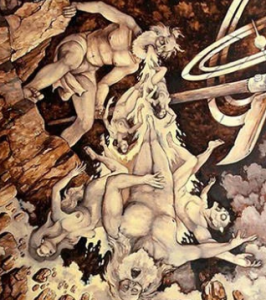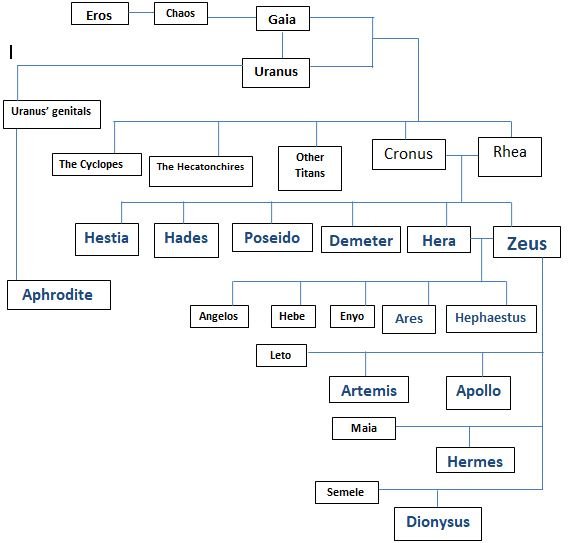Greek Goddess Hestia – Birth, Symbols, Appearance, & Powers

Hestia goddess – symbols and powers
Hestia is the ancient Greek goddess of the hearth and sacrificial flame. Regarded as one of the three maiden goddesses in Greek mythology, Hestia was the daughter of Kronos (Cronos) and Rhea the King and Queen of the Greek Titans.
As Hestia is the goddess of hearth, she is usually depicted as a modest woman sitting on a wooden throne. The typical symbols of Hestia are fire, cows, and pigs. Unlike other Olympian deities, the worship of Hestia was not extensive in ancient Greece, featuring in a few places such as Sparta and Ermioni. The Roman equivalent of Hestia is Vesta. Read on to discover the major myths and facts about Hestia, the Greek goddess of the hearth and sacrificial fire.
Quick Facts about Hestia’s Family
Goddess of: the hearth, state, family, domestic affairs and the home
Parents: Rhea and Kronos
Siblings: Demeter, Hades, Hera, Poseidon, Zeus
Consort: None
Issues: None
Association: Hermes, Athena and Artemis
Worship places: Sparta, Delos
Symbols: fire, the hearth, pig, cow, wine, oil
Other names: Estia
Epithets: “Goddess of Domestic Life”, “Giver of all domestic happiness”, “The Royal Hearth”; “She of the Public Hearth”
Roman equivalent: Vesta
Birth of Hestia
The goddess Hestia is the daughter of Titans Kronos and Rhea. This makes her the oldest of her siblings – Demeter, Hades, Hera, Poseidon, and Zeus.
Hestia was believed to have been born twice. In the first one, she is seen as the eldest of her siblings. In this account, she was also the first child to get swallowed by the mad Titan Kronos. Shortly after, Kronos swallowed the remaining four children of his.
Owing to quick thinking by Rhea, Zeus, the youngest of his siblings, was able to avoid the sad event that befell his siblings. A mature and stronger Zeus would later return and force Kronos to vomit his siblings from his stomach. This is where Hestia’s second birth comes. She was the last child to be disgorged by Kronos.
It is for the above reason Hestia is referred to as the “first and last” [deity] of the original six Olympians.

Mad Titan disgorging Hestia and her four other siblings – Hera, Hades, Poseidon, and Demeter
Meaning of her name
Generally, Hestia’s name invokes a sense of “hearth” or “fireplace”. On the other hand, her name could also mean “home” or “family”. The third and final meaning of Hestia pertains to the state. For example, in almost every Greek prytaneum (the administrative seat of government), a huge hearth dedicated to Hestia was found. It was in those places where ancient Greeks offered several sacrifices and prayers to the Greek gods. The hearth was also a place for people to gather and form strong social and civic bonds. Hearths of those natures made Hestia commonly associated with issues of community or state well-being.
Hestia’s eternal vow of chastity
In sharp contrast to many Greek gods and goddesses, Hestia never had a consort or a husband. She, along with goddesses Athena and Artemis, committed herself to remain an eternal virgin. Thus, Hestia, Artemis and Athena make up the famous three virgin goddesses whose hearts cannot be bend or ensnared by romantic love (Not even by Aphrodite, the Greek goddess of love).
Owing to this vow, Zeus – the king of the gods – elevated Hestia to the position of royal hearth, arguably the highest honor any god can receive on Mt. Olympus. It is for this reason some accounts of the story describe her as the “chief of the goddesses” (maiden divinity), even above Hera and Athena.
Hestia’s oath remained unshakable, turning down love proposals from Poseidon and Apollo. Owing to this, her fellow gods always came to her defense whenever another deity threatened her chastity. In one incidence, Priapus – a minor god of fertility, fruits and male genitalia – attempted to rape Hestia who was sleeping. An ass’s braying caused Hestia to wake up and fend of Priapus who was then severely beaten by the gods for his transgressions.
What are the major symbols of Hestia?
Popular symbols of Hestia are fire, the hearth, cow (baby cows), and a pig.
Appearance and Depictions of Hestia
Of all the Twelve Olympians, Hestia is one of the least portrayed deities. And even when she is shown, she is depicted as a modest woman in very humble clothes with a hood over her head. In her hands was generally a staff or a fire. And as if those depictions weren’t modest enough, Hestia’s throne is a simple wooden throne.
Hestia’s depictions in modest manner stem from the belief that she was particularly concerned with maintaining the family and domestic affairs of the community. Unlike the drama-packed lives and adventures of her siblings and other Greek gods, Hestia remained glued to her task. For this, she earned the respect and admiration of all the gods.
The goddess of the hearth has also been described as pure and peaceful; she typically maintains a non-confrontational attitude.
Worship

Community centers such as Delos Prytaneion had public hearths that symbolized the goddess Hestia
The hearth played an integral part in the homes of ancient Greeks. It was used for heating and cooking for centuries. The fireplace/hearth often took center stage in the house, enabling the family to offer sacrifices and prayers to the gods. It was believed that Hestia received the richest portion of every sacrifice and prayer made to Greek gods at a hearth.
Hestia’s most preferred sacrificial animal was believed to be a domestic pig. Other accounts say that she instead preferred a one-year old cow.
The ancient Greeks paid enormous attention in the maintenance of the hearths found in temples and community centers (prytaneum or agora). They believed that the fire had a direct bearing on the cohesion and unity in the community. Not properly maintained, and the society could be plunged into chaos. When lighting up a hearth fire, the Greeks performed a number of special rituals and prayers.
Women were usually chosen as the heads of Hestia’s cult and temples. These women were also the matriarchs in their families. At the community or state level however, a high ranking civil servant or powerful state official was chosen to lead the prayers to Hestia.
Compared to other Greek deities, Hestia did not have many dedicated cult centers and temples. This was because the Greeks believed that every temple in the land was the dwelling place of Hestia. However, there quite a number of temples dedicated to Hestia at Sparta and Ermioni.
Importance of Hestia in Ancient Greece
Almost all temples in ancient Greece – be it the ones at Delphi (i.e. the temple of Apollo) or at the great hall in Mycenae – had hearths installed in order to offer prayers and sacrifices to various Greek deities. Because those hearths were seen as the embodiment of Hestia, ancient Greece revered Hestia as the gateway to the divinity on Mt Olympus; i.e. she was seen as a mediator between Greeks and their gods.
The goddess Hestia played a significant role in almost all domestic spheres of the Greek society, i.e. socially, religiously and politically. Her importance derives from the uses of the hearth, which was used for cooking, offering of sacrifices, and keeping the home warm.
Owing to the above, ancient Greeks reserved the first and last offerings of wine to Hestia. Similarly, it was believed that Hestia deserved the best portion of sacrifices meant for the Greek gods.
Family Tree

Greek goddess Hestia’s family tree
Other Interesting Myths about the Greek Goddess Hestia
- As families in ancient Greece moved from placing importance on the religious aspects in a home, so did the hearth fade into obscurity.
- Hestia’s half-brother was called Chiron – the wisest and most just of all the centaurs in Greek mythology. Ancient Greeks believed that Chiron was responsible for teaching a great deal of heroes, including Achilles, Ajax, Theseus, Perseus, Heracles (Hercules), Jason, Aeneas, Odysseus, etc. Chiron even tutored Dionysus, the Greek god of wine and pleasure.
- The Greek goddess Hestia did have some level of following at Delos.
- In ancient Greece, the act of carrying the fire from one’s mother town to a new town symbolized the maintenance of Hestia’s domestic blessings.
- She was responsible for keeping the fires of the hearth on Mount Olympus burning continuously. She did this by using the fatty portions of the sacrificed meat to the gods as fuel.
- In some cases, Hestia was omitted from the twelve Olympian gods. The Greek god of wine, Dionysus, often took her place in such cases. Such was her importance, and by extension the importance of the hearth, that placing her among the 12 Olympians is a bit redundant. Hestia was the first to be invoked during all a sacrifices. That alone shows how much ancient Greece and Rome revered her.
- Vesta was the name the ancient Romans gave to Hestia. Like the Greeks, Romans attributed similar qualities, attributes and functions to the goddess Vesta.
- In the month of June, the Romans usually celebrated a festival called Vestalia in honor of the goddess Vesta. During the festival, people walked bare foot and offered prayers and sacrifices to Vesta.
- Hestia and Hermes (the messenger of the gods) were believed to be the ones who showed mankind the art of building houses.
- In a very popular hymn to the goddess Aphrodite, the writers heap enormous praises on Hestia and Hermes.

Homeric Hymn 29, which heaps praises on Hestia and the Greek god Hermes



























